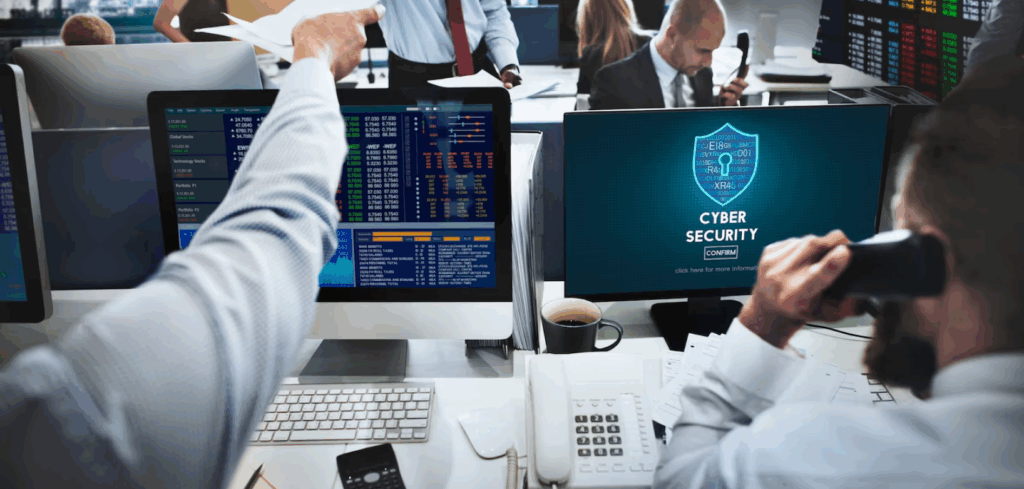
October 2025 marks the 22nd year of a simple idea with outsized impact: Small, consistent habits make the internet safer for everyone.
Led by agencies like the Cybersecurity and Infrastructure Security Agency (CISA) and various other national bodies, this month-long campaign emphasizes that cybersecurity is everyone’s responsibility in today’s digital age.
Cyber threats didn’t hit pause over the past year—they multiplied, morphed, and got sneakier. Yet the playbook for everyday defense remains refreshingly clear. This guide updates our 2024 article with fresh insights, practical tips, and ready‑to‑use activities for Cybersecurity Awareness Month 2025. Use it to run a campaign at work, level up your personal security, or kick‑start a new career path in cybersecurity.
Why Cybersecurity Matters In 2025?
The digital world has become critical to our personal and professional lives, making cybersecurity a critical issue. In 2025, the rise in cyber threats such as data breaches, ransomware attacks, and phishing scams has dramatically increased, impacting both individuals and businesses alike.
“There’s no silver bullet solution with cybersecurity, a layered defense is the only viable defense.” – James Scott, Institute for Critical Infrastructure Technology.
What’s New (And Urgent) In 2025
Attackers have gotten louder and faster. Cybercriminals are becoming smarter, and their attacks are more difficult to detect. Some of the ways they are increasing the complexity of their attacks include:
- AI and Automation: Hackers are using artificial intelligence to launch more advanced and personalized phishing attacks.
- Targeted attacks: Instead of random attacks, cybercriminals are now focusing on high-value targets, such as government agencies, healthcare systems, and financial institutions.
- Exploiting New Technologies: With the rise of smart devices and the Internet of Things (IoT), more entry points are available for cybercriminals to exploit.
Common Attack Scenarios To Rehearse
- Invoice change fraud: Finance receives a “new bank account” email from a vendor. Verification path? Dual approvals?
- Payroll diversion: HR gets a request to switch direct‑deposit details. Out‑of‑band verification required.
- Deepfake voice: A “CEO” calls about a rushed payment. Require call‑back to a known number or a shared passphrase.
- QR (quishing) lure: Posters or emails push a QR code to a fake login page. Train people to verify source and URL previews.
While this is a small list, here are all the security threats you should be aware of.
How To Protect Your Digital World
Our digital world has made it tough for almost all of us to keep our data and information safe from cyberattacks. However, there are numerous ways to prevent it to an extreme level. Let’s have a look at some of them:
For individuals
- Harden the inbox: Turn on spam filters, flag suspicious messages, and unsubscribe from “grey noise” newsletters you never read.
- Lock down accounts: Enable MFA on your email, financial apps, and social media. Rotate weak or reused passwords first.
- Secure your devices: Full‑disk encryption on laptops/phones, auto‑lock in under 2 minutes, and AirTag/Find‑My equivalents enabled.
- Backups that actually work: One cloud backup + one local backup. Test a file restore once this month.
- Home network basics: Change default router passwords, disable WPS, and update router firmware. Consider a guest Wi‑Fi for visitors and smart‑home devices.
For small businesses & teams
- Minimum‑viable policy kit: Acceptable Use, Password/MFA, Patch Management, and Incident Response one‑pagers. Keep them short enough that people actually read them.
- Least privilege in practice: Review admin rights quarterly. Remove stale accounts (including former vendors and interns).
- Phishing drills + report button: Run a realistic simulation, then measure “report” rates—not just click rates. Reward fast reporters.
- Third‑party exposure: Inventory critical vendors and their access. Ensure contracts require MFA, timely patching, and breach notification.
- Backup and restore tests: Snapshot a critical system weekly and test a restore. A backup isn’t a backup until it’s restored.
The “Secure Our World” essentials
1) Use strong, unique passwords
Length beats complexity. Aim for 14+ characters. Let a password manager generate/store one‑of‑a‑kind passwords for every account.
2) Turn on multi‑factor authentication (MFA)
Start with email, banking, cloud storage, and any work apps. Prefer authenticator apps or hardware keys over SMS when possible.
3) Update software—routinely
Enable automatic updates for your OS, browsers, phone, VPN, and router. Reboot after big patches so protections actually apply.
4) Recognize and report scams
Slow down on links and attachments—especially “urgent” messages about payments, payroll, or account security. When in doubt, verify via a trusted channel. At work, report suspicious messages so security teams can warn others.
Pro Tip: Create a 15‑minute monthly reminder on calendars. During this time, update browsers, OS, and popular apps(even if auto-update is enabled). Check router firmware at home.
Your October 2025 Campaign: Week‑by‑week
Use this flexible outline for internal communications, workshops, or social posts. Swap weeks as needed.
- Week 1 – Passwords & Managers: Run a 20‑minute demo of a password manager. Give a checklist: replace the top 5 weak/reused passwords; add recovery methods.
- Week 2 – MFA Everywhere: Publish a how‑to for enabling MFA on Microsoft 365/Google Workspace, banking apps, and payroll/HR portals.
- Week 3 – Update & Patch: Announce patch update day. Share a list of critical apps to update (OS, browsers, VPNs, routers, Wi‑Fi cameras, NAS).
- Week 4 – Spot & Report Scams: Post real examples (sanitized) of phishing, vishing, and quishing. Explain your team’s “report” workflow, response SLAs, and who to contact.
Conclusion
As the Cybersecurity Awareness Month 2025 theme emphasizes, “Secure Our World” is a shared responsibility. Whether you’re securing personal devices or managing a business IT infrastructure, the steps you take now can help protect against future cyber threats. Stay vigilant, keep informed, and make cybersecurity a priority not just during Cybersecurity Awareness Month 2024 but year-round.
If you’re ready to advance your cybersecurity skills, opt for the CCI Training Center Cybersecurity Program. We look forward to helping you secure your future!
Program Offered
- Pharmacy Technician Training
- Online Medical Assistant
- Medical Billing and Coding Specialist Program
- Cloud Computing Technician Training
- Computer Network Technician
- Business and Accounting
- Radiology Technician Training
- Medical Assistant Program
- Computer Support Technician
- Cybersecurity Program
- Virtual Assistant Training

This article is written by
Share this article
Frequently Asked Questions FAQ's
What is Cybersecurity Awareness Month 2025?
A month‑long initiative (October 1–31) that encourages individuals and organizations to adopt simple, high‑impact security habits.
Is “Secure Our World” still the theme?
Yes. The message continues because it works: strong passwords, MFA, timely updates, and scam awareness are the highest‑leverage moves for most people.
Do I need expensive tools to participate?
Not at all. Start with policies, training, updates, and identity protections. Many organizations run impactful campaigns with lightweight tooling and existing comms channels.
Program Offered
- Pharmacy Technician Training
- Online Medical Assistant
- Medical Billing and Coding Specialist Program
- Cloud Computing Technician Training
- Computer Network Technician
- Business and Accounting
- Radiology Technician Training
- Medical Assistant Program
- Computer Support Technician
- Cybersecurity Program
- Virtual Assistant Training

This article is written by
Share this article
Related Articles


















